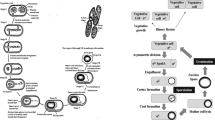Abstract
The mechanism of dehydration inactivation of Lactobacillus plantarum cells after vacuum-drying above saturated salt solutions was studied. The method used is based on the hypothesis that DNase diffuses into cells with damaged cell membranes/walls and hydrolyses the intracellular DNA. Intact, undamaged cells and cells inactivated by either dehydration or heat treatent were incubated in the presence of DNase. The release of DNA hydrolysis products into the incubation medium was measured. It was shown that dehydration inactivation of L. plantarum, but not thermal inactivation, was associated with clear evidence of membrane damage. The residual glucose-fermenting activity of the dehydrated cells related to the release of hydrolysed DNA in the medium, but there was no such relationship with heat-treated cells. Addition of sorbitol to cells before dehydration increased the residual glucose-fermenting activity after drying and this was associated with a reduced rate of DNA hydrolysis. It is concluded that cell wall and/or cell membrane damage is an important mechanism of dehydration inactivation, but that thermal inactivation (up to 60°C) occurs by a different mechanism.
Similar content being viewed by others
References
Bradford MM (1976) A rapid and sensitive method for the quantification of microgram quantities of protein utilizing the principle of protein-dye binding. Anal Biochem 72:248–254
Brennan M, Wanismail B, Johnson MC, Ray B (1986) Cellular damage in dried Lactobacillus acidophilus. J Food Prot 49:47–53
Burton K (1956) A study of the conditions and mechanism of the diphenylamine reaction for the colometric estimation of deoxyribonucleic acid. Biochem J 62:315–323
Herbert D, Phipps PJ, Strange RE (1971) Chemical analysis of microbial cells. Methods Microbiol 5B:317–320
Hutchison WC, Munro HN (1961) The determination of nucleic acids in biological materials. The Analyst 86:768–813
Jenness R, Koops J (1962) Preparation and properties of a salt solution which simulates milk ultrafiltrate. Neth Milk Dairy J 16:153–164
Lammers WL, Noomen A (1990) Release of DNA as an indicator for lysis of Lactococcus lactis ssp. cremoris. FEMS Microbiol Rev 87:P114
Lievense LC, Van't Riet K (1994) Convective drying of bacteria. II. Factors influencing the survival. Adv Biochem Biotechnol 51:in press
Lievense LC, Van't Riet K, Noomen A (1990a) Measuring and modelling the glucose-fermenting activity of Lactobacillus plantarum. Appl Microbiol Biotechnol 32:669–673
Lievense LC, Verbeek MAM, Meerdink G, Van't Riet K (1990b) The inactivation of Lactobacillus plantarum during drying II. Measurement and modelling of the thermal inactivation. Bioseparation 1:171–180
Lievense LC, Verbeek MAM, Taekema T, Meerdink G, Van't Riet K (1992) Modelling the inactivation of Lactobacillus plantarum during a drying process. Chem Eng Sci 47:87–97
Morichi T, Irie R, Yano N, Kembo H (1967) Death of freeze-dried Lactobacillus bulgaricus during rehydration. Agric Biol Chem 31:137–141
Neidhardt FC, Ingraham JL, Schaechter M (1990) Physiology of the bacterial cell: a molecular approach. Sinauer Associates, Sunderland, Mass., pp 3–4
Price PA (1975) The essential role of Ca2+ in activity of bovine pancreatic deoxyribonuclease. J Biol Chem 244:917–923
Schlegel HG (1986) General microbiology, 6th edn. Cambridge University Press, Cambridge, UK, p 3
Vassault A (1983) Lactate dehydrogenase analysis. In: Bergmeyer HU (ed) Methods of enzymatic analysis, vol 3. Verlag Chemie, Weinheim, pp 118–126
Wagman J (1960) Evidence of cytoplasmic membrane injury in the drying of bacteria. J Bacteriology 80:558–564
Webb SJ (1961) Factors affecting the viability of air-borne bacteria. Can J Microbiol 7:621–632
Young JF (1967) Humidity control in the laboratory using salt solutions — a review. J Appl Chem 17:241–245
Author information
Authors and Affiliations
Additional information
Correspondence to: K. van't Riet
Rights and permissions
About this article
Cite this article
Lievense, L.C., Verbreek, M.A.M., Noomen, A. et al. Mechanism of dehydration inactivation of Lactobacillus plantarum . Appl Microbiol Biotechnol 41, 90–94 (1994). https://doi.org/10.1007/BF00166087
Received:
Revised:
Accepted:
Issue Date:
DOI: https://doi.org/10.1007/BF00166087




